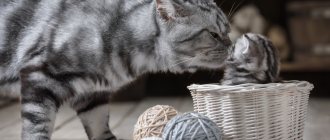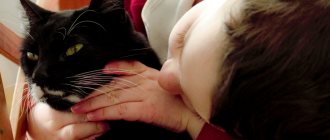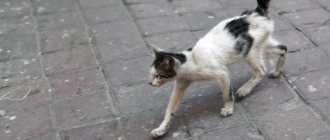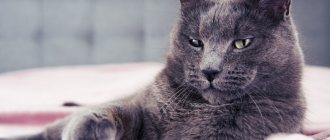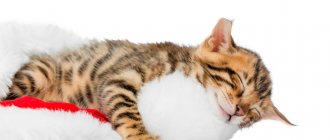The curiosity and active lifestyle of domestic cats often play a cruel joke on them, causing a foreign object to enter the gastrointestinal tract. The owner of a furry fidget must know not only the symptoms of the disease, but also what to do in such a situation, what danger a foreign object poses in the animal’s body. Often, in order to save the life of a pet, a veterinarian has to resort to surgery.
Why does a cat swallow objects?
Experienced breeders and veterinarians know that most often the penetration of foreign bodies occurs through the digestive tract. Curious cats, playing with various objects that come into their field of vision, often swallow them. Especially often, during the operation, veterinarians discover caps from valerian, parts of children's construction sets, coins, construction waste, and burst balloons.
The peak of calls regarding animals swallowing a foreign object usually occurs during the New Year holidays. Bright tinsel, small Christmas tree decorations, parts of garlands, and Christmas tree decorations attract the attention of curious cats with their shine and rustle.
Furry couch potatoes are partial to handicraft items (threads, needles, buttons, decorative elements) and fishing gear (line, hooks, spoons, wobblers, etc.).
The risk group includes small kittens and young animals. Due to natural curiosity and lack of life experience, young animals try new objects and often swallow them. Animals left to their own devices for a long time are also at risk. A bored cat tries to entertain itself by playing with foreign objects. Veterinarians also consider hair balls in a cat's stomach to be a dangerous foreign body.
We recommend reading about how to cure a cat’s runny nose and sneeze at home. You will learn about the possible causes of sneezing in cats, home treatment methods, and preventive measures. And here is more information about why a cat coughs, as if it was choking.
What not to do if your cat vomits after swallowing a foreign object!
- If vomiting increases, you should not give him food or drink. This is due to the fact that substances in this state of the body will not be absorbed, and the vomiting process will only intensify, which will further dehydrate the animal’s body.
- Perform an enema. The pressure of water can create additional pressure on the intestinal walls, which threatens rupture.
- Give a laxative. This also threatens the animal with rupture of the tissues of internal organs.
- Avoid taking antiemetic medications. They will only relieve the symptom and can mask the disease for some time that will be lost.
- Hoping that it will go away on its own. Don’t waste time, the sooner the animal falls into experienced hands, the faster it will be cured.
Even after the “accident,” your pet continues to eat inedible objects. Perhaps he has a disease - picanism. Scientists say that it occurs against the background of a lack of attention, education and boredom of the animal or a lack of any elements in the diet. A loving owner will always find a way out of this situation by organizing proper nutrition and leisure for his four-legged friend. If you feed your cat natural food, do not forget about vitamins. Specialized toys will help diversify your furry pet's leisure time, making it safe. Extra bones and treats will satisfy the desire to learn new things and clean teeth.
Getting various objects into the stomach of pets that can clog or injure the digestive tract is a very common problem. What veterinary surgeons don’t find during operations!
A foreign body in a cat’s stomach is a fairly serious phenomenon that threatens the pet’s life and requires surgical intervention.
Is a foreign body really dangerous?
A foreign body entering the digestive tract can lead to the following health problems:
- dehydration due to vomiting and the animal’s refusal to drink water;
- pathologies of cardiac activity up to complete cardiac arrest due to penetration of a sharp object through the wall of the stomach into the pericardium;
- violation of the integrity, numerous ruptures and damage to the mucous membrane throughout the gastrointestinal tract when a foreign body moves due to peristalsis;
- ulcerative lesions of the stomach, small and large intestines;
- necrotic processes due to prolonged presence of non-sterile objects in internal organs;
- blockage, intussusception, intestinal obstruction;
- perforation of the walls of internal organs with sharp objects;
- peritonitis with a high mortality rate.
Veterinary specialists, understanding the danger of a pet swallowing an inedible object, strongly recommend that owners closely monitor their pets and have an idea of what clinical signs are typical for this situation.
Examples of foreign bodies in the gastrointestinal tract of animals from our practice
And in conclusion, I would like to present to you a selection of items that my colleagues and I extracted from our patients:
Rice. 7. Cat. A foreign body from the large intestine is a piece of a shower sponge (see Fig. 6). Rice. 8. Foreign body from the cat's stomach - hair bands that the cat ate 3 years ago (see Fig. 1). Rice. 9. A foreign body from the small and large intestines of a cat - tinsel on a wire (see Fig. 4). Rice. 10. Foreign bodies from the small intestine of a cat - threads with helminths. Rice. 11. A foreign body from a dog’s stomach is a toy. Rice. 12. A foreign body from the cat’s large intestine – a piece of insulation (see Fig. 5).
Symptoms in a cat
Ingestion of a foreign object does not always occur before the eyes of the owner. The discovery of the loss of one or another item in the room and the inadequate condition of the cat should cause alarm among household members and force them to take a closer look at the presence of the following symptoms in the pet:
- When an inedible object gets stuck in the esophagus, severe salivation is observed.
- When an object is localized in the pharynx, the cat coughs, wheezes, and may experience cyanosis of the tongue and loss of consciousness.
- The animal is anxious, stretches its neck, and makes frequent swallowing movements.
- Constant vomiting, belching. The duration of vomiting can last from several hours to several days, depending on the severity of the damage to the digestive canal and the location of the object.
- Complete lack of appetite, the animal refuses even its favorite treat.
- Pain in the abdomen, accumulation of gases, bloating.
- Lethargic and apathetic state, drowsiness.
- Stool retention, diarrhea, constipation.
- Reducing the amount of feces.
- With chronic obstruction, cachexia develops due to decreased appetite.
- Signs of general intoxication of the body.
Bearing in mind the danger of foreign bodies entering the gastrointestinal tract of a domestic cat, the owner should immediately take the animal to a specialized clinic.
Indications for gastroscopy in cats
Clinical indications for gastroscopy are:
- dysphagia;
- vomiting blood;
- acute and chronic vomiting;
- foreign bodies;
- intense salivation (salivation);
- regurgitation;
- polyphagia;
- acute and chronic pain in the upper gastrointestinal tract;
- neoplasia;
- dilation of the esophagus detected by X-ray;
- esophageal strictures identified by contrast or non-contrast radiography.
What to do when a cat swallows an object
Veterinary experts strongly recommend that owners who discover that a cat has swallowed a foreign body not take any independent action. Lack of professional skills and knowledge will lead to even more severe consequences for the pet’s health.
For example, you should not give petroleum jelly, which can cause intussusception when a foreign body is in it. Under no circumstances should you induce vomiting if there is a suspicion that a sharp object, alkali or petroleum product has been swallowed.
The owner must ensure that the animal does not take food or water before visiting the veterinarian, provide the cat with complete rest and urgently take it to a specialized clinic.
Causes of gastric obstruction in cats
Why do domestic cats swallow inedible objects? Polyphagia - a perversion of appetite that manifests itself in some pathologies, when animals purposefully eat everything - is quite rare. The reasons for swallowing various things are in most cases quite banal, and gastric obstruction in a cat is most often a consequence of:
- a game in which the cat accidentally swallows an object;
- eating inedible things that have a pleasant smell, for example, a bag containing meat or sausage packaging;
- chewing rustling objects (cats like to chew cellophane, tinsel, etc.);
- feeding bones, especially those that have undergone heat treatment;
- accumulations of wool in the stomach.
Small objects can remain in the lumen of the stomach, completely blocking its work, or pass into the intestines, causing obstruction in the lower gastrointestinal tract.
Swallowed threads, ribbons, rain from the Christmas tree - what surgeons call linear bodies, are capable of stretching along a significant portion of the gastrointestinal tract, collecting intestinal loops, injuring the walls of organs, causing perforation and necrosis.
If part of a swallowed linear body is visible from the cat's anus, under no circumstances should you pull it out! Such objects very rarely leave the body on their own; if pulled, they can simply cut the intestines.
Some small objects can gradually accumulate in the stomach if their size does not allow them to pass further into the duodenum, causing a gradual increase in symptoms and deterioration in the cat's well-being.
Sharp objects such as needles and bones in a cat's stomach can injure the stomach wall, causing cuts and punctures, affecting nearby organs and migrating into the abdominal cavity.
Diagnostics in a veterinary clinic
After taking a history and physical examination, the veterinarian begins special examination methods to visualize the foreign object. The following diagnostics are used in veterinary practice:
- Survey radiography of the abdominal organs. It is carried out in two projections: direct and lateral. For a more detailed study, radiography is carried out in a vertical and horizontal position of the furry patient. The method allows you to determine the presence and location of radiopaque objects (metal needles, paper clips, etc.).
On the radiograph: a penny in the intestines of a cat
- To visualize foreign objects such as plastic, threads, a radiopaque substance is used, which is injected into the animal’s body.
- Ultrasound examination of the digestive canal and organs of the thoracic and abdominal cavity. The method allows you to detect intestinal obstruction and determine the state of intestinal motility.
- Using a fiber optic fiberscope, your pet will undergo an endoscopic examination of the esophagus and stomach in a specialized institution. The method is effective if no more than 3-4 hours have passed since the foreign body was swallowed.
Laboratory methods for examining blood and urine are of an auxiliary nature and are necessary for the differential diagnosis of intestinal obstruction due to an infectious disease, intoxication, etc.
Possible consequences
For domestic cats, thread often becomes a subject of play and the pet can swallow it along with the needle, which is very dangerous for your pet’s health. A cat's tongue is designed in such a way that the animal cannot independently remove debris from it. Accordingly, the pet will be forced to swallow the thread and needle. Only in 7% out of 100 does it happen that the needle passes through the esophagus and leaves the body naturally. However, you should not rely on luck in such situations and it is better to immediately provide help to your pet as soon as you notice that the cat has eaten a needle.
Once in the body, the needle can damage internal organs and this can happen at any time, even a few days after ingestion. Initially, the cat may not react in any way to what happened and will continue to lead normal life activities. If the needle damages the esophageal mucosa, the following symptoms may occur:
:
- Refusal to eat;
- Fever;
- Lethargy;
- Urge to vomit.
Removal by operation
You can preserve the health, and sometimes even the life, of your beloved pet if it swallows foreign objects with the help of surgical intervention performed by an experienced veterinarian.
From the intestines
When intestinal obstruction is confirmed by radiographic and ultrasound methods, the surgeon, as a rule, decides to perform diagnostic laparoscopy. During the operation, the foreign body is removed and the intussusception is reduced. If necessary (in cases of necrosis), part of the intestine is resected.
To learn how to remove a foreign object from a cat’s intestines using enterotomy, watch this video:
From the stomach
In rare cases, it is possible to remove a foreign object from the stomach using diagnostic gastroscopy. If a foreign body is detected in the stomach of a domestic cat using endoscopic, x-ray or ultrasound examination, the surgeon usually decides to perform a gastrotomy.
Removal of threads from the stomach during gastrotomy
Having gained immediate access, the stomach is held in place using ligatures. The foreign body is removed using instruments or palpation. After suturing the mucous membrane and muscle layers, the organ is returned to its anatomical location. The operation is performed under general anesthesia.
From the esophagus
If the location of the foreign body is the esophagus, in some situations it is possible to remove it using an endoscope. If the object is large, the surgeon can perform an esophagotomy. The operation is indicated if the x-ray shows perforation of the walls of the esophagus, or the foreign body is large and has sharp edges.
Often the veterinarian resorts to the following manipulation. Using an endoscope, an object is pushed into the stomach, after which the animal undergoes a gastrotomy, followed by removal of the foreign body.
Removing a foreign body (needle and thread) using an endoscope.
After laparotomy, gastrotomy or esophagotomy, the animal is prescribed a 24-hour fasting diet. Subsequently, the operated pet receives liquid food in small portions. Weakened and dehydrated animals must undergo infusion therapy. To prevent peritonitis and postoperative complications, a course of antibacterial drugs is prescribed.
In complicated cases, the pet is left after surgery for 2-3 days in a specialized institution, using parenteral nutrition. A follow-up ultrasound examination is required after surgery.
We recommend reading about why a cat has bloody stool. You will learn about the reasons for the appearance of blood in the stool, the actions of the owners before going to the veterinary clinic, diagnosis and treatment. And here is more information about how to give an enema to a cat.
If the cat swallows the rope and its condition worsens
While observing the animal, you began to notice that its condition was deteriorating. He became restless, lies down, refuses to eat, vomits, and does not go to the toilet. to take the cat to the veterinary clinic as soon as possible
, where he will be examined and a contrast X-ray examination will be done, which will rule out or confirm blockage of part of the intestine. The pet will be given a liquid containing barium. It will surround the foreign object inside the animal and make it visible to technology. Based on the examination, the doctor will decide on surgery, which cannot be avoided if diagnosed with intestinal obstruction.
If your veterinary office does not have diagnostic equipment, then the doctor will perform an exploratory laparotomy when diagnosing intestinal obstruction. The animal will be given anesthesia and within half an hour, the doctor will examine the pet’s internal organs and remove the blockage in the right place. Two days later, after such an operation, the animal returns to its previous rhythm of life.
Prevention
Knowing about the serious consequences and threat to life when swallowing foreign objects, the owner must strictly follow the following recommendations of veterinary specialists:
- keep the room in which your furry pet lives clean;
- there should be no small items on the floor or within the reach of the animal;
- the feed must be checked for the presence of foreign impurities;
- It is unacceptable to feed a cat bones;
- Toys for your pet should be soft and large in size.
Penetration of a foreign body into the digestive canal of a pet is a dangerous phenomenon for health and life. The animal must be urgently taken to a specialized facility for special diagnostic procedures to visualize the swallowed item. As a rule, treatment comes down to surgical removal of the foreign body by laparoscopy, gastrotomy or esophagotomy, depending on its location.
Similar articles
- Foreign body.
This is not a harmless reason often... In addition to sneezing, the animal experiences shortness of breath, the cat often sleeps with its mouth open. Foreign body. This not harmless reason is often the cause of sneezing in a cat. Read more - How to give an enema to a cat correctly, is it possible to perform...
The animal stops licking itself and avoids communication. Touching the belly causes anxiety in the cat. ... traumatic injuries to the anus and intestines, including the entry of foreign bodies Read more
- Foreign body. Swallowing sharp objects...
Therefore, if a cat has blood in its stool, this indicates that the pet’s health is not in order. ... If the cause of the symptoms is a foreign body, polyps, malignant formations, then the pet can help... Read more
- How to treat a cat’s wound (open, purulent) after...
After the damaged surface is free of debris, dirt and foreign bodies, it is necessary to begin antiseptic treatment. What to use to treat an open wound on a cat... Read more
- Treatment of otitis media in cats: symptoms of purulent and fungal...
Injuries, foreign bodies entering the ear canal. ... Symptoms of otitis media in a cat. Inflammatory phenomena in the ear canal have characteristic features that cannot escape the attention of an observant owner Read more
Symptomatic manifestations
A serious pathology - intestinal obstruction - is expressed by fairly clear symptoms that allow you to quickly diagnose the disease and begin treatment in a timely manner. Symptoms of pathology depend on the character and habits of the animal:
- Some cats begin to actively run and meow loudly and forcefully, trying to attract the owner’s attention to their problem. Others, on the contrary, become lethargic and apathetic, and experience excessive sleepiness.
- In all cases, the animal loses its appetite, up to a complete refusal to eat, even despite the growing feeling of hunger. Any piece of food swallowed by a pet cannot be completely digested and causes unbearable pain.
- The animal begins to vomit, which is of an increasing nature.
- The pet's belly is greatly and quite noticeably enlarged, which he does not allow to touch, since the slightest touch causes him severe pain. When palpating such a belly, tension and hardness are clearly felt; sometimes you can even feel foreign objects.
- The animal experiences increased gas production, which further inflates the abdominal area. At the same time, some individuals constantly lick their belly and roll on the floor, thus trying to relieve attacks of pain.
- When constipated, the animal suffers from the inability to relieve the intestines, it has insignificant stool. With intestinal obstruction, feces cannot leave the animal’s body at all, no matter how hard it tries.
All these symptoms indicate the development of intestinal obstruction in your pet, and it is quite difficult not to notice them. As soon as an animal exhibits abnormal behavior that is not characteristic of it, it is necessary to immediately contact a veterinary clinic, where, using the necessary diagnostic methods, doctors will be able to make the correct diagnosis and prescribe the necessary treatment.
Treatment of intestinal obstruction
It is optimal to take the animal to a veterinary clinic immediately after refusing to eat. Even if it is not an intestinal obstruction, the veterinarian will have a short window of time to make a more accurate diagnosis. If after palpation the doctor suspects an obstruction, the cat will be prescribed:
- Blood and urine analysis to determine the degree of damage and toxicity.
- X-ray with contrast agent. The drug is administered orally to more clearly display the obstruction on the image.
- Depending on the clinical picture, surgery is performed, if time permits, the animal is placed under a drip and an attempt is made to physically flush the intestines.
It should be noted that surgical intervention is necessary if the intestines are clogged with insoluble substances, for example, a lump of cellophane or the animal’s condition is critical. During surgery, a fragment of the intestine is often removed, the walls of which have been irrevocably damaged, or, in other words, rotted. In other cases, the veterinarian will recommend “fighting” the disease on an outpatient basis - treatment at home with a mandatory visit to the doctor.
Important! Until the diagnosis is finalized, the cat should not be given laxatives! If the cause of the blockage is a foreign body, spasms can cause intestinal rupture. Never give your cat laxatives without consulting your doctor; many human medications are toxic to animals!
With intestinal obstruction in cats, symptoms and methods of treatment are closely related, and the latter depends on the intensity of the former. This is a rather severe pathology caused by blockage of the digestive organs by some foreign body, tumor, intussusception, or complete intestinal paralysis. Without timely treatment, absolutely all animals with intestinal obstruction die within a few days. The insidiousness of this disease is that this pathology can happen at any time to any cat. Therefore, timely diagnosis can sufficiently alleviate the pet’s suffering and even save its life.
In the stomach of any animal there is a continuous production of large amounts of digestive juices. This process is absolutely independent of food intake and occurs even during prolonged fasting. The main function of the intestines is to push the contents of the stomach towards the anus. As they move through the organ, these digestive juices are absorbed back through the intestinal walls, but along with nutrients, carrying out a constant circulation of large amounts of vital fluid.
In case of intestinal pathology, namely, obstruction of the organ, regardless of the reasons that caused it, this turnover is disrupted: gastric juice is produced in the same volume, but it can no longer be absorbed along with the food being promoted.
What to do if a cat has a stomach obstruction?
If the described symptoms appear or if the cat was caught red-handed, it is very important to immediately contact a veterinary clinic, preferably a well-equipped one, where a gastroenterologist is seen.
If a small object was swallowed by a cat no more than half an hour ago, then it can be removed using a gastroscope. When the animal’s condition is serious or it is known that something sharp has entered the stomach, then an emergency diagnostic laparotomy is performed - opening the abdominal cavity in order to find and remove a foreign body.
In controversial cases, with good health and unclear localization of the object, a series of studies described above is first carried out. If there are a lot of objects, it is very important to know where they are, since such operations are often accompanied by tissue incision in several places, which is difficult for the body to tolerate.
How to help at home?
Swallowed inedible objects in most cases cause obstruction of the digestive tract, which can only be treated surgically. When it is not possible to see a veterinarian, owners can observe the cat for a while - this will help make at least some predictions.
Once a foreign body is in a cat's stomach, there is a chance that it will be vomited out within the next 2 hours. If this does not happen, but the animal feels well, and the size and type of the object allow us to hope that it did not cause a blockage of the gastrointestinal tract, you can give petroleum jelly 10 ml 4 times a day and carefully monitor whether it is passed out in the feces .
Under no circumstances should you give laxatives that affect peristalsis! This increases the risk of intussusception, an even more dangerous condition.
Unfortunately, there are no therapeutic methods for treating a blockage or injury to the stomach (for example, if a cat damaged its stomach with fish bones).
Cats cannot understand the danger of all those toys that they grab with their mouths. It is the owners who must protect their pets as much as possible from the possibility of swallowing something extra. You should not give them bones, you should remove small objects and threads from the floor, hide bags, and refuse to decorate the Christmas tree with New Year's rain. These simple rules can save a cat's life.
A foreign body is any object that accidentally ends up in an unusual place. If we talk about the cat’s digestive tract, then a foreign body is any object that is not food. These could be clumps of wool, sewing thread, bone fragments, etc.
General symptoms.
In most cases, symptoms depend on the location of the object, and therefore on the irritation it causes, as well as on the extent to which the foreign object has blocked the digestive tract. Common symptoms include the following:
♦ profuse salivation (especially if a foreign body is stuck in the esophagus);
♦ belching and/or vomiting. It can last from several hours to several weeks, if the obstruction is partial;
♦ complete lack of appetite;
♦ lethargy and drowsiness;
♦ bloating, due to a large accumulation of gases in the intestines;
♦ weight loss (this is in the case of chronic obstruction).
Causes.
The fact is that cats are very careful and attentive to what goes into their mouth, this distinguishes them from dogs. But sometimes, when playing too hard, they can accidentally swallow a foreign body.
Very often, kittens are attracted to the shiny New Year's rain hanging from the Christmas tree. Or pieces of bright thread (rope). And if these objects get into the cat's mouth, then it is very difficult for her to spit them out, as a result, they swallow them.
How serious is this?
If it is a small foreign body and does not have any notches, then it will simply pass through the digestive tract without causing any problems. A large or irregularly shaped foreign body (for example: a piece of bone, a tuft of hair) can partially, and in rare cases completely block the digestive tract. In this case, the cat's life is threatened.
Almost all cats are at risk, but cats are especially affected
,
and other oriental breeds
, which are known for their abnormal predilection for eating tissue.
Your actions.
If you know or suspect that your cat has ingested a foreign body, or if you notice any of the signs described above, contact your veterinarian immediately. Do not feed your cat or allow her to put anything in her mouth until you have been examined by a veterinarian.
Prevention.
Never leave small or colorful items, especially if you have kittens in the house, in an easily accessible place. The best place for such items is a box or box with a tight-fitting lid.
Health to you and your pets.
Cats and cats are very curious creatures. Moreover, they strive to try everything that interests them. The tongue is covered with hard villi, which are directed in such a way that if something gets into the animal’s oral cavity, it cannot spit it out and is forced to swallow.
About Vaseline oil
Vaseline oil is a purified fraction of petroleum without harmful organic substances and their compounds, mixes with fats and oils and has the properties of petroleum jelly. Without being absorbed into the walls of the gastrointestinal tract, it envelops the obstacle in the form of feces, softens them and facilitates the process of pushing. Indication: constipation. Contraindication: intestinal obstruction.
So we come to a difficult dilemma: or obstruction? With constipation, accumulation and hardening of stool usually occurs in the middle and lower intestines. And Vaseline oil is your first friend here. It can also help with partial obstruction.
In case of complete obstruction, the oil will aggravate the situation, becoming an additional burden in the gastrointestinal tract. In addition, it can “drag through” a foreign object a little, damaging the intestinal walls and causing their necrosis.
Thus, giving a cat Vaseline oil when there is a blockage is a risk: it may solve the problem, or it may worsen the situation.
